U.S. Department of Transportation
Federal Highway Administration
1200 New Jersey Avenue, SE
Washington, DC 20590
202-366-4000
Federal Highway Administration Research and Technology
Coordinating, Developing, and Delivering Highway Transportation Innovations
|
LTPP News This newsletter is an archived publication and may contain dated technical, contact, and link information. |
|
| Publication Number: FHWA-HRT-13-074 Date: Spring 2013 |
Publication Number:
FHWA-HRT-13-074
Issue No: Vol. 9 No. 2 Date: Spring 2013 |
| Email Distribution List |
|
| Contact |
Customer Service
|
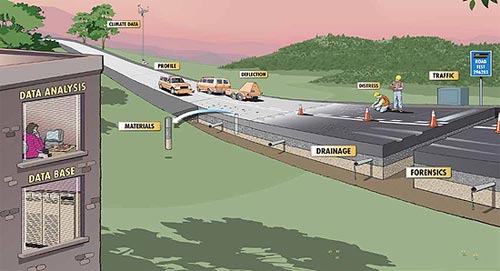
The Long-Term Pavement Performance (LTPP) program has recently taken delivery of four new, state-of-the-art inertial profiling units. The competitively procured profilers were manufactured by Ames Engineering to meet LTPP’s stringent acceptance criteria. The new devices replace LTPP profilers that were procured in 2002 and collectively logged more than 1.2 million miles.
The new LTPP profilers were specified and manufactured so the results from the testing regimen closely match legacy LTPP data collection parameters.
The new profilers not only collect longitudinal profile data, but have also added new capabilities. Pavement macrotexture measurements are a new data collection element, and all of the data, including ambient and surface temperature, is now referenced with Global Positioning System (GPS) coordinates. The cockpit of the vehicle has been designed to minimize driver distractions and provide ease of access to all controls and testing switches.As compared to the old LTPP profilers that used 2002-era computer technology, the new system’s hardware requirements are minimized resulting in a very low computer rack footprint. System software has been designed through a collaborative manufacturer/LTPP program process to be user-friendly and intuitive.
 The new LTPP profilers |
The new LTPP profilers were procured and accepted for service using a very strict procedure. This procedure could be leveraged by other agencies that are procuring inertial profilers to check the ability of the equipment to collect consistent, accurate profile and macrotexture data. The acceptance procedure, conducted in February 2013 near College Station, Texas, consisted of the following checks:
Static Sensor Test: Researchers evaluated the precision and bias of the profile and texture height sensors in the static mode.
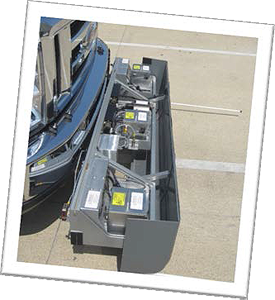 Sensor Chassis |
Bounce Test: Researchers checked if the accelerometers were cancelling out vehicle motion, and as an overall test on the integrity of the profiling system.
Test on Distance Measuring Instrument (DMI): Researchers evaluated the precision and bias of the DMI.
Profile Initiation Test: Researchers evaluated the ability of the vertical and horizontal photocell to initiate data collection.
Ability of Devices to Detect Profile Features: Researchers investigated the ability of the profiler to correctly detect profile features.
 Rack Equipment |
Repeatability of Profile Data: Researchers analyzed this to determine the ability of the devices to collect repeatable profile data.
Repeatability of International Roughness Index (IRI) Values: Researchers compared IRI values computed from the profile data collected by the devices to determine the ability of the devices to obtain repeatable IRI values.
Cross Correlation Analysis—IRI Repeatability of Profile Data: Researchers performed this check to evaluate the repeatability of IRI values along the section.
Comparison of IRI Values with Reference Device IRI: Researchers performed this check to compare the IRI values obtained by the test devices with IRI values computed from the data collected by a reference device.
Cross Correlation Analysis—IRI Accuracy of Profile Data: Researchers performed this check to evaluate the accuracy of IRI values along the section compared to IRI from data collected by the reference device.
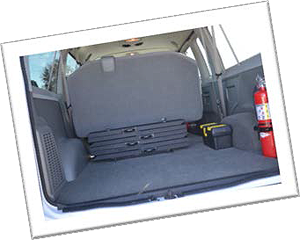 Calibration Ramps |
Waveband Analysis of Profile Data: Researchers performed this check to compare the spectral distribution of the profile data collected by the test devices with data collected by a reference device.
Evaluation of Accuracy of Texture Laser in the Dynamic Mode: Researchers evaluated the accuracy of the texture lasers in the dynamic mode by utilizing the texture laser evaluation tool provided by the manufacturer.
Evaluation of Data Collected by the Texture Lasers: Researchers compared Mean Profile Depth (MPD) values computed from macrotexture data collected by texture lasers to MPD values obtained from a reference device.
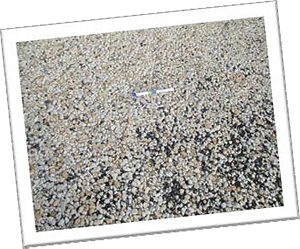 Chip Seal Surface |
In order to conduct the acceptance testing, several reference test sections were established near College Station, Texas. These sections consisted of two asphalt concrete, two Portland cement concrete (PCC), and one chip seal surface. The sections were selected to obtain a range of roughness and MPD values.
The results were analyzed and it was found that all four profilers met the stated requirements. A week-long training exercise held in April paved the way for the program to incorporate the new devices into production mode for LTPP.
For agencies interested in LTPP profiler operations, specifications, and acceptance criteria, please contact Larry Wiser (Larry.Wiser@dot.gov) or LTPP Customer Service at ltppinfo@dot.gov.
To obtain a copy of the LTPP data, newsletter, or for more information about the program, please contact the LTPP Customer Support Service Center at ltppinfo@dot.gov or (202) 493-3035.
Visit the LTPP Website at: https://www.fhwa.dot.gov/research/tfhrc/programs/infrastructure/pavements/ltpp/
Curl and Warp Analysis of The LTPP SPS-2 Site in Arizona (TechBrief)
FHWA-HRT-13-040 2012 [PDF]
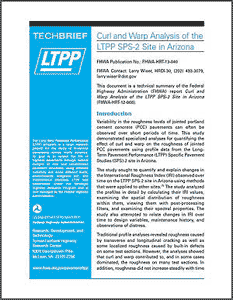 |
Variability in the roughness levels of jointed PCC pavements can often be observed over short periods of time. This study demonstrated specialized analyses for quantifying the effect of curl and warp on the roughness of jointed PCC pavements using profile data from the LTPP Specific Pavement Studies (SPS)-2 site in Arizona. Traditional profile analyses revealed roughness caused by transverse and longitudinal cracking and some localized roughness caused by built-in defects on some test sections. However, the analyses showed that curl and warp contributed to, and in some cases dominated, the roughness on many test sections. In addition, roughness did not increase steadily with time because of diurnal and seasonal changes in slab curl and warp. |